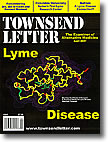"Finally, we are opening
the Columbia University Lyme Disease Research Center, a state-of-the-art
interdisciplinary center dedicated to helping
hundreds of thousands of people suffering from Lyme and associated
tick-borne diseases. The center will fast-track scientific studies
focused on improving diagnostic tools and treatment.
"These studies are expected to earn NIH funding for further basic
research on unresolved questions about the spirochetes (spiral-shaped
bacteria)
that cause Lyme disease.
"The New Jersey-based national Lyme Disease Association and the
Connecticut-based organization Time For Lyme spent five years raising
$3 million to start
up the Columbia Lyme center. Now that this primary goal has been
achieved, let the research begin and the breakthroughs emerge."
Diane Blanchard,
Co-President, Time for Lyme

This April, a new center for research on chronic Lyme disease is scheduled
to open at Columbia University. Pat Smith, president of the Lyme Disease
Association (LDA), hailed the Columbia center as "the first of
its kind in the world devoted to addressing the multiple possible causes
of persistent symptoms from Lyme disease." Establishment of the
center, Ms. Smith said, is the outgrowth of a "legal partnership" entered
into by the LDA, Time for Lyme (TFL, an affiliate of the LDA), and
Columbia University during the summer of 2002. Subsequently, the LDA
and TFL led efforts to raise the $3 million necessary to launch a multi-disciplinary
university center. Brian Fallon, MD, MPH, will direct the center's
research programs. Dr. Fallon, a specialist in neurological Lyme disease,
is Associate Professor of Clinical Psychiatry, Columbia University
College of Physicians and Surgeons.
 "We are all excited that an academic medical center as prestigious
as Columbia University has committed itself to focus scientists and
the
latest biotechnologies toward unraveling the problem of chronic Lyme
disease," exclaimed Ms. Smith, who noted that Columbia University "has
already been at the forefront internationally in research on neurological
Lyme." Contemplating materialization of the center, she commented:
"Patients with Lyme disease, whose manifestations in some cases can
be as devastating
as congestive heart failure, deserve the respect, focus, and funds
that Columbia University can generate." Lyme disease, she pointed
out, has become "the most prevalent vector-borne infection in
the US, and unlocking the secrets of its debilitating chronic effects
is urgent." "We are all excited that an academic medical center as prestigious
as Columbia University has committed itself to focus scientists and
the
latest biotechnologies toward unraveling the problem of chronic Lyme
disease," exclaimed Ms. Smith, who noted that Columbia University "has
already been at the forefront internationally in research on neurological
Lyme." Contemplating materialization of the center, she commented:
"Patients with Lyme disease, whose manifestations in some cases can
be as devastating
as congestive heart failure, deserve the respect, focus, and funds
that Columbia University can generate." Lyme disease, she pointed
out, has become "the most prevalent vector-borne infection in
the US, and unlocking the secrets of its debilitating chronic effects
is urgent."
This reporter interviewed Dr. Fallon for Townsend
Letter's issue
on Lyme disease. The interview follows:
MC: Dr. Fallon, when and how did you get involved in Lyme disease?
BF: I first became interested in Lyme disease in 1990 when my wife
(a psychiatrist at Yale) and I (a psychiatrist at Columbia) received
a telephone call from Polly Murray, who lived with her children in
Old Lyme, Connecticut. It was Polly Murray who first noticed an odd
clustering of arthritis among children in Old Lyme, and it was her
persistent letters to the public health authorities that led to the
first reports of Lyme arthritis in the United States in 1976.
When Polly Murray told my wife and me that she suspected Lyme disease
was causing prominent neuropsychiatric symptoms in her neighbors with
Lyme, we became curious. We made a home visit, interviewed her neighbors
with Lyme disease, then conducted a survey of over 1,000 people in
the United States diagnosed with Lyme. The results surprised us; we
learned that depression occurred far more commonly in these Lyme disease
patients than in patients with lupus or rheumatoid arthritis.
 MC: Some 17 years have passed since your first encounter with Lyme.
What were the steps between point A and the opening of the Columbia
Lyme Center with you as director? MC: Some 17 years have passed since your first encounter with Lyme.
What were the steps between point A and the opening of the Columbia
Lyme Center with you as director?
BF: As a researcher, I began to study the neuropsychiatric aspects
of Lyme disease in adults and children more objectively. I also became
interested in the dilemma faced by patients regarding treatment: some
physicians said no more antibiotic was needed; others said patients
needed treatment until the symptoms were gone. The fact was that these
patients were quite sick, very disabled as a result of the initial
tick bite and infection. Why? And what was the best treatment strategy
to help them?
These questions led me to conduct a number of research studies, including,
most recently, a $4.7 million re-treatment study of chronic Lyme encephalopathy
funded by the National Institutes of Health (NIH). The idea of the
Center at Columbia emerged several years ago, based on a recognition
that far more scientific work needed to be done on the problem of Lyme
disease, particularly the problem of why patients were persistently
symptomatic.
MC: In a paragraph, can you state the "mission" of the
new center – as you envision it?
BF: The Center will engage in multi-disciplinary scientific research
relevant to the spiral-shaped bacterium that causes Lyme disease, such
as how it might evade antibiotics or lead to persistent symptoms even
when no longer present. On the clinical side, the Center will address
unresolved problems concerning diagnostic tools and treatments.
MC: Can you give readers of this report a rundown of funding for the
center's research activities?
BF: All of the funding for the Center to date has come from the work
of private foundations, most notably TFL and the LDA, as well as from
very generous individual donors within their relatives and friends.
The Center's "start-up" contains funds for an endowment
(providing interest income annually) to support ongoing Lyme and tick-borne
disease research at Columbia. The "start-up" also contains
funds for new research projects, some of which have already begun.
For example, we've hired a post-doc in microbiology, Dr. Rafal
Tokarz, to work with Dr. Ian Lipkin at Columbia to apply previously
unavailable molecular genetic technologies to determine whether persistent
symptoms in humans might be caused by previously unidentified organisms
in ticks.
Outside Columbia, we're funding a project on proteomics (analysis
of miniscule amounts of proteins expressed by spirochetes – i.e.,
Lyme bacteria) with Dr. Steven Schutzer at the University of Medicine
and Dentistry of New Jersey. Dr. Schutzer's study aims to identify
a more sensitive diagnostic tool for Lyme disease.
MC: You mentioned earlier a recent study you conducted, which received
nearly $5 million in NIH funds; that's for one study. The Columbia
center's start-up funds amount to $3 million. Where will you
look for additional research funds?
BF: Research is an expensive enterprise, and the NIH funding has become
much more limited compared to the number of applications for grants.
They are now much less likely to take risks with novel ideas. Thus,
it is necessary to have the private foundation funds to allow for pilot
studies that can test out creative hypotheses on a small scale that
later will be approved for NIH funding on the larger scale. As a Center,
we have committed ourselves to continue providing research funds to
support research being conducted by investigators from around the world.
Projects will be evaluated using a multi-institutional scientific review
board to ensure unbiased awards. We recognize that we will regularly
need the generous support of private foundations and individual donors
to fund this international grant program.
Our Center also has a strong educational component. This year, we launched
two fellowships, one in Lyme-related molecular biology and one in clinical
diagnosis and treatment. We expect the results of these pilot research
investigations to lead, as they have in the past, to NIH funding.
MC: What do you see farther along the research road?
BF: Symptoms may persist in patients for a variety of reasons, reflecting
a complex interaction of various mechanisms, including persistent infection,
autoimmunity, tissue damage from prior infection, and imbalances in
neurotransmitters or neurohormones. The portfolio of clinical research
for the new chronic Lyme disease research center at Columbia will likely
include a wide range of treatment approaches. Among those under consideration
are promising herbal treatments, non-IV antibiotics, immune modulators,
and neuroactive agents.
MC: The second paragraph of this report quotes Pat Smith on the elation
she feels at the opening of the Columbia center. In the broadest sense,
what's your view of the role of the new center at Columbia University
in the Lyme world?
BF: One of the difficult aspects of illness is feeling sick. Another
very difficult aspect is having an illness that is the source of so
much confusion in the medical community regarding its cause and treatment.
Patients with very disabling symptoms from Lyme disease are sometimes
dismissed by doctors. The presence of this Lyme Center in a nationally
prominent academic medical institution sends a clear message to these
patients that not only are they being taken seriously by medical scientists
but, with the joint effort of leading researchers and the support of
the community, scientific breakthroughs can occur that will ease their
symptoms.
|



![]()
![]()


 "We are all excited that an academic medical center as prestigious
as Columbia University has committed itself to focus scientists and
the
latest biotechnologies toward unraveling the problem of chronic Lyme
disease," exclaimed Ms. Smith, who noted that Columbia University "has
already been at the forefront internationally in research on neurological
Lyme." Contemplating materialization of the center, she commented:
"Patients with Lyme disease, whose manifestations in some cases can
be as devastating
as congestive heart failure, deserve the respect, focus, and funds
that Columbia University can generate." Lyme disease, she pointed
out, has become "the most prevalent vector-borne infection in
the US, and unlocking the secrets of its debilitating chronic effects
is urgent."
"We are all excited that an academic medical center as prestigious
as Columbia University has committed itself to focus scientists and
the
latest biotechnologies toward unraveling the problem of chronic Lyme
disease," exclaimed Ms. Smith, who noted that Columbia University "has
already been at the forefront internationally in research on neurological
Lyme." Contemplating materialization of the center, she commented:
"Patients with Lyme disease, whose manifestations in some cases can
be as devastating
as congestive heart failure, deserve the respect, focus, and funds
that Columbia University can generate." Lyme disease, she pointed
out, has become "the most prevalent vector-borne infection in
the US, and unlocking the secrets of its debilitating chronic effects
is urgent."  MC:
MC: